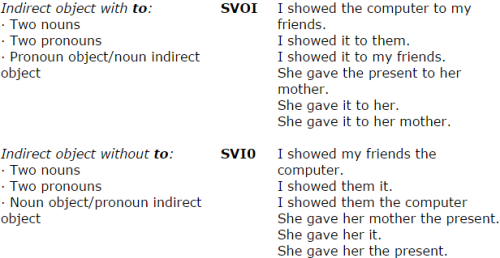Ordering of Words
Most English sentences (clauses) conform to the SVO word order. This means that the Subject comes before the Verb, which comes before the Object. Examples:
- I (S) bought (V) a new computer (O).
- She (S) doesn't like (V) dogs (O).
- Why did you (S) do (V) that (O)?
It is more complicated when an indirect object (I) is added to the sentence. In this case the word order depends a.) on whether the direct and indirect objects are nouns or pronouns, and b.) on whether the indirect object is preceded by the word to. Here are the basic rules:
Basic Rules:

MIND IT !
Many English sentences also contain adverbials. The problem for the English learner is that some adverbials can be located in different places within the sentence, while other adverbials must appear in one place only. For example, it is correct to say both: I very quickly did my homework .. and I did my homework very quickly .., but only I did my homework in a hurry ..is possible. I in a hurry did my homework .. is wrong.
LearnFrenzy provides you lots of fully solved "Ordering of Words" Questions and Answers with explanation.
